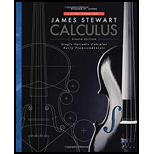
Study Guide for Stewart's Single Variable Calculus: Early Transcendentals, 8th
8th Edition
ISBN: 9781305279148
Author: Stewart, James, St. Andre, Richard
Publisher: Cengage Learning
expand_more
expand_more
format_list_bulleted
Concept explainers
Textbook Question
Chapter 1.1, Problem 3PT
The implied domain of
- a) (1, ∞)
- b) (−∞, 1)
- c) x ≠ 1
- d) (−1, 1)
Expert Solution & Answer
Trending nowThis is a popular solution!

Students have asked these similar questions
Find:
lim x →-6 f (x)
limx-4 f (x)
lim x-1 f (x)
lim x →4 f (x)
(-6,3) •
(-1,5)
-8
-7
(-6,-2)
4+
(4,5)
(4,2) •
(-1,1)
-6
3
2
Find:
ƒ(1)
lim f(x)
14-x
2
ƒ(2)
lim f(x)
x-2-
lim f(x)
x+2+
lim f(x)
x→4
3
y=f(x)
what can the answer be pls help
Chapter 1 Solutions
Study Guide for Stewart's Single Variable Calculus: Early Transcendentals, 8th
Ch. 1.1 - True or False: x2 + 6x + 2y = 1 defines y as a...Ch. 1.1 - Prob. 2PTCh. 1.1 - The implied domain of is:
(1, ∞)
(−∞, 1)
x ≠...Ch. 1.1 - Prob. 4PTCh. 1.1 - Prob. 5PTCh. 1.1 - Prob. 6PTCh. 1.2 - Prob. 1PTCh. 1.2 - Prob. 2PTCh. 1.2 - Prob. 3PTCh. 1.2 - Prob. 4PT
Ch. 1.3 - Prob. 1PTCh. 1.3 - Prob. 2PTCh. 1.3 - Prob. 3PTCh. 1.3 - Prob. 4PTCh. 1.3 - Prob. 5PTCh. 1.3 - Prob. 6PTCh. 1.3 - Prob. 7PTCh. 1.4 - Prob. 1PTCh. 1.4 - A mosquito population of 100 grows to 500 after...Ch. 1.4 - Prob. 3PTCh. 1.4 - Prob. 4PTCh. 1.5 - A function f is one-to-one means:
if x1 = x2, then...Ch. 1.5 - Prob. 2PTCh. 1.5 - Prob. 3PTCh. 1.5 - Prob. 4PTCh. 1.5 - Prob. 5PTCh. 1.5 - True or False:
ln(a + b) = ln a + ln b.
Ch. 1.5 - Prob. 7PTCh. 1.5 - Prob. 8PTCh. 1.5 - Prob. 9PT
Knowledge Booster
Learn more about
Need a deep-dive on the concept behind this application? Look no further. Learn more about this topic, calculus and related others by exploring similar questions and additional content below.Similar questions
- Good Day, Would appreciate any assistance with this query. Regards,arrow_forwardThis question builds on an earlier problem. The randomized numbers may have changed, but have your work for the previous problem available to help with this one. A 4-centimeter rod is attached at one end to a point A rotating counterclockwise on a wheel of radius 2 cm. The other end B is free to move back and forth along a horizontal bar that goes through the center of the wheel. At time t=0 the rod is situated as in the diagram at the left below. The wheel rotates counterclockwise at 1.5 rev/sec. At some point, the rod will be tangent to the circle as shown in the third picture. A B A B at some instant, the piston will be tangent to the circle (a) Express the x and y coordinates of point A as functions of t: x= 2 cos(3πt) and y= 2 sin(3t) (b) Write a formula for the slope of the tangent line to the circle at the point A at time t seconds: -cot(3πt) sin(3лt) (c) Express the x-coordinate of the right end of the rod at point B as a function of t: 2 cos(3πt) +411- 4 -2 sin (3лt) (d)…arrow_forward5. [-/1 Points] DETAILS MY NOTES SESSCALCET2 6.5.AE.003. y y= ex² 0 Video Example x EXAMPLE 3 (a) Use the Midpoint Rule with n = 10 to approximate the integral कर L'ex² dx. (b) Give an upper bound for the error involved in this approximation. SOLUTION 8+2 1 L'ex² d (a) Since a = 0, b = 1, and n = 10, the Midpoint Rule gives the following. (Round your answer to six decimal places.) dx Ax[f(0.05) + f(0.15) + ... + f(0.85) + f(0.95)] 0.1 [0.0025 +0.0225 + + e0.0625 + 0.1225 e0.3025 + e0.4225 + e0.2025 + + e0.5625 €0.7225 +0.9025] The figure illustrates this approximation. (b) Since f(x) = ex², we have f'(x) = 0 ≤ f'(x) = < 6e. ASK YOUR TEACHER and f'(x) = Also, since 0 ≤ x ≤ 1 we have x² ≤ and so Taking K = 6e, a = 0, b = 1, and n = 10 in the error estimate, we see that an upper bound for the error is as follows. (Round your final answer to five decimal places.) 6e(1)3 e 24( = ≈arrow_forward
arrow_back_ios
SEE MORE QUESTIONS
arrow_forward_ios
Recommended textbooks for you
 Elements Of Modern AlgebraAlgebraISBN:9781285463230Author:Gilbert, Linda, JimmiePublisher:Cengage Learning,
Elements Of Modern AlgebraAlgebraISBN:9781285463230Author:Gilbert, Linda, JimmiePublisher:Cengage Learning, Linear Algebra: A Modern IntroductionAlgebraISBN:9781285463247Author:David PoolePublisher:Cengage Learning
Linear Algebra: A Modern IntroductionAlgebraISBN:9781285463247Author:David PoolePublisher:Cengage Learning

Elements Of Modern Algebra
Algebra
ISBN:9781285463230
Author:Gilbert, Linda, Jimmie
Publisher:Cengage Learning,

Linear Algebra: A Modern Introduction
Algebra
ISBN:9781285463247
Author:David Poole
Publisher:Cengage Learning
Limits and Continuity; Author: The Organic Chemistry Tutor;https://www.youtube.com/watch?v=9brk313DjV8;License: Standard YouTube License, CC-BY